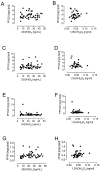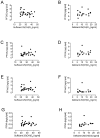Association of Vitamin D with Perfluorinated Alkyl Acids in Women with and without Non-Obese Polycystic Ovary Syndrome
- PMID: 38927462
- PMCID: PMC11201284
- DOI: 10.3390/biomedicines12061255
Association of Vitamin D with Perfluorinated Alkyl Acids in Women with and without Non-Obese Polycystic Ovary Syndrome
Abstract
Background: Perfluorinated alkyl acids (PFAAs) are persistent organic pollutants affected by BMI and ethnicity, with contradictory reports of association with vitamin D deficiency.
Methods: Twenty-nine Caucasian women with non-obese polycystic ovary syndrome (PCOS) and age- and BMI-matched Caucasian control women (n = 30) were recruited. Paired serum samples were analyzed for PFAAs (n = 13) using high-performance liquid chromatography-tandem mass spectrometry. Tandem mass spectrometry determined levels of 25(OH)D3 and the active 1,25(OH)2D3.
Results: Women with and without PCOS did not differ in age, weight, insulin resistance, or systemic inflammation (C-reactive protein did not differ), but the free androgen index was increased. Four PFAAs were detected in all serum samples: perfluorooctane sulfonic acid (PFOS), perfluorooctanoic acid (PFOA), perfluorononanoic acid (PFNA), and perfluorohexane sulfonic acid (PFHxS). Serum PFOS was higher in PCOS versus controls (geometric mean [GM] 3.9 vs. 3.1 ng/mL, p < 0.05). Linear regression modeling showed that elevated PFHxS had higher odds of a lower 25(OH)D3 (OR: 2.919, 95% CI 0.82-5.75, p = 0.04). Vitamin D did not differ between cohorts and did not correlate with any PFAAs, either alone or when the groups were combined. When vitamin D was stratified into sufficiency (>20 ng/mL) and deficiency (<20 ng/mL), no correlation with any PFAAs was seen.
Conclusions: While the analyses and findings here are exploratory in light of relatively small recruitment numbers, when age, BMI, and insulin resistance are accounted for, the PFAAs do not appear to be related to 25(OH)D3 or the active 1,25(OH)2D3 in this Caucasian population, nor do they appear to be associated with vitamin D deficiency, suggesting that future studies must account for these factors in the analysis.
Keywords: IVF; PCOS; PFAAs; PFHxS; PFNA; PFOA; PFOS; endocrine disrupting chemicals; perfluorinated alkyl acids; polycystic ovary syndrome.
Conflict of interest statement
The authors declare no conflicts of interest.
Figures


Similar articles
-
Perfluorinated alkyl acids in the serum and follicular fluid of UK women with and without polycystic ovarian syndrome undergoing fertility treatment and associations with hormonal and metabolic parameters.Int J Hyg Environ Health. 2018 Aug;221(7):1068-1075. doi: 10.1016/j.ijheh.2018.07.009. Epub 2018 Jul 20. Int J Hyg Environ Health. 2018. PMID: 30037723
-
Perfluoroalkyl acids in pregnant women from Nunavik (Quebec, Canada): Trends in exposure and associations with country foods consumption.Environ Int. 2020 Dec;145:106169. doi: 10.1016/j.envint.2020.106169. Epub 2020 Oct 9. Environ Int. 2020. PMID: 33041046
-
Inflammatory Markers in Non-Obese Women with Polycystic Ovary Syndrome Are Not Elevated and Show No Correlation with Vitamin D Metabolites.Nutrients. 2022 Aug 27;14(17):3540. doi: 10.3390/nu14173540. Nutrients. 2022. PMID: 36079796 Free PMC article.
-
Oxidative Stress Markers and Heat Shock Proteins in Non-Obese Women with Polycystic Ovary Syndrome Are Not Elevated and Show No Correlation with Vitamin D.Biomedicines. 2023 Jul 20;11(7):2044. doi: 10.3390/biomedicines11072044. Biomedicines. 2023. PMID: 37509682 Free PMC article.
-
Exposure to Perflouroalkyl acids and foetal and maternal thyroid status: a review.Environ Health. 2020 Oct 13;19(1):107. doi: 10.1186/s12940-020-00647-1. Environ Health. 2020. PMID: 33050930 Free PMC article. Review.
References
LinkOut - more resources
Full Text Sources
Research Materials

